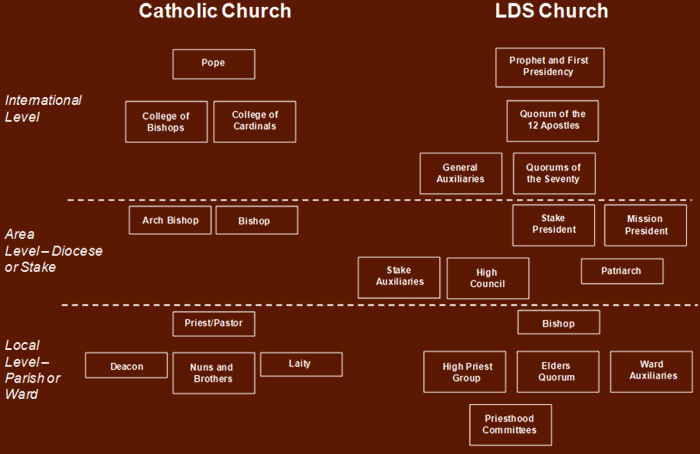 The Lord's Church The Lord's Church
Structure of the Church of Jesus Christ
Catholic Doctrine
The structure of the Catholic Church is apostolic, meaning the
foundation of the Church is built upon the principle that
apostolic succession has come from the original Twelve Apostles
(mainly Peter) to the present day Pope and the college of bishops
who govern the church today.
The Church is usually locally organized into parishes, which are
then grouped geographically into dioceses.
NOTE:
My research on the hierarchy of the Catholic Church
uncovered sometimes conflicting information on organizational
structures and on how they interact in the Church. My brief
descriptions are a synthesis from these various sources.
Exceptions abound.
The Church hierarchy includes the following ten ecclesiastical
components:
The Pope
The Pope is "head of the college of bishops, the Vicar of Christ
and Pastor of the universal Church on earth" (Catechism 936). The
Pope Ministers on behalf of Christ on earth to lead the Church as
a shepherd would lead his flock. Other titles of the Pope include
the Successor of Peter, the Bishop of Rome, and the Holy Roman
Pontiff.
The College of Bishops
The College of Bishops is made up of all the bishops of the
Catholic Church. These bishops are the successors of the Twelve
Apostles. The purpose of the College is to assist in the
governance of the Catholic Church. As the leader of the College of
Bishops, the Pope determines how the power of the College is to be
employed, while having the authority to call or dismiss a council
(i.e. a gathering of bishops to discuss doctrine or ecclesiastical
matters) with the final approval of all decisions made by the
council. Hence, the Council’s authority is predicated upon its
ability to be united with the Pope.
The College of Cardinals
Cardinals are appointed by the Pope but have no more
ecclesiastical authority than that of bishops, although one might
argue their political influence exceeds that of a bishop under
specific circumstances related to their appointment. The College
of Cardinals is made up of select bishops who are assigned a
special status and position. The primary purpose of the College of
Cardinals is to advise the Pope on select matters determined by
him. Beginning in 1059 to the present, when the Pope passes away,
the College of Cardinals elects a new Pope from among its ranks.
Before that time elections were conducted by the clergy and the
people of the diocese of Rome.
Synod of Bishops
The Synod of Bishops can be thought of as a continuation of the
Second Vatican Council, whereby the Synod meets in Rome as a
scheduled advisory board to the Pope to consider selected issues
and develop official Church teaching.
Magisterium
The Magisterium is the “keeper and preserver” of official Catholic
Church teachings. The Magisterium is called upon to interpret the
word of God, which may originate as scripture or tradition. The
teachings of the Catholic Church adhere to the standards on faith
and morals taught by the Apostles. The Magisterium guards this
adherence.
Bishops
Appointed by the Pope, bishops preside over diocese. A diocese is
made up of a number of parishes in a given geographic region. A
bishop may be appointed to the office of an archbishop, who
presides over a territory that would be considered larger than
average or be located in an area or city of significant
importance. There is no difference in authority between an
archbishop and a bishop.
Priests
Priests take a vow of obedience to the bishop and are typically
assigned to a parish to minister to the people, exercise
ecclesiastical authority over the parish, and manage its
day-to-day operations.
Deacons
Deacons are ordained male assistants to bishops and priests.
Deacons help by performing certain spiritual duties. These include
the distribution of the Eucharist, proclaiming the gospel,
assisting matrimonial services, baptizing, presiding over
funerals, and other like ministerial activities. Deacons are not
authorized to consecrate the Eucharist. There is no female
equivalent to the position of a deacon.
Nuns and Brothers
A woman who feels a vocation to the religious life in the Catholic
Church and is willing to take a vow of chastity, charity,
obedience, and poverty for life can become a nun. There are many
different orders of sisterhood in the Catholic Church, each
community having a set of rules approved by Rome. Men who
feel called to live a religious life, but not as a priest or
deacon, can become a brother in various communities approved by
Rome. A brother will take vows similar to those taken by nuns,
including chastity and obedience.
Lay Ministers
Catholics who take an active role in Church service, but who do
not choose the religious life, can become lay ministers. Lay
ministers can occupy paid parish positions or can be volunteers.
Their work is usually directed by the parish pastor or other
authorized parish personnel. These lay ministers are “…made to
share in the priestly, prophetical, and kingly office of Christ;
they have therefore, in the Church and in the world, their own
assignment in the mission of the whole People of God” (Catechism
873).
See Catechism 873, 869,
936, 2032, and glossary. Also see
www.catholic-pages.com,
www.bible.ca/catholic-church-hierarchy-organization.htm, and
Canon 336 and 338 of the 1983 Code of Canon Law.
Latter-day Saints
Doctrine
The Church of Jesus Christ of Latter-day Saints is the restored
church of Jesus Christ on earth. It is patterned after the church
established by Jesus Christ during his public ministry. Following
the ascension of Christ and through the centuries that followed,
men changed the ordinances and doctrines established by the
savior, including the organization of the Church.
The result of these changes led to the propagation of sects and
ushered in the period in western history known as the “Dark Ages”
(approximately A.D. 400 to A.D. 1,000). Amos prophesied of this
period when he said there would be “a famine in the land, not a
famine of bread, nor a thirst for water, but of hearing the words
of the Lord. … They shall … seek the word of the Lord, and shall
not find it” (Amos 8:11–12). Christ also knew that this apostasy
would take place and prophesied of a restoration when through the
prophet Isaiah he said “I will proceed to do a marvelous work
among this people, even a marvelous work and a wonder” (Isaiah
29:14).
The restoration of the Church of Jesus Christ included a full
restoration of the structure of the Church, beginning with
restoration of the authority of the priesthood. In 1829 both the
Aaronic and Melchizedek Priesthoods were restored to the earth,
laying the ground work for this revelation given through the
prophet Joseph Smith in April of 1830: “The rise of the Church of
Christ in these last days, being one thousand eight hundred and
thirty years since the coming of our Lord and Savior Jesus Christ
in the flesh, it being regularly organized and established
agreeable to the laws of our country, by the will and commandments
of God, in the fourth month, and on the sixth day of the month
which is called April” (D&C 20:1).
This revelation inspired the direction that the Church would be
organized with the same offices as during the time of Christ’s
public ministry, including “Apostles, prophets, seventies,
evangelists (patriarchs), pastors (presiding officers), high
priests, elders, bishops, priests, teachers, and deacons” (Gospel
Principles 112). Chapter 8 defines these offices of the
priesthood in more detail. The commitment of the Church to
restoring and maintaining the same ecclesiastical structure as
during the time of Christ on earth is stated in the 6th Article of
Faith: “We believe in the same organization that existed in the
Primitive Church, namely, apostles, prophets, pastors, teachers,
evangelists, and so forth” (Articles of Faith 1:6).
The Church has grown and become more complex than it was in the
early days—growing from six members in 1830 to over 13 million
members world wide in 2007. The Lord has revealed the changes
necessary to adapt to this growth and complexity. For example,
local wards (similar to Catholic parishes) are now organized into
stakes (akin to small Catholic dioceses). Stake presidents (akin
to bishops in the Catholic Church) preside over these stakes. high
councils, each consisting of 12 priesthood leaders answering to
the stake president, have been established to provide a structure
at the local level that echoes that of the Church as a whole with
its twelve apostles answering to the Prophet. Each structural
component comes about through revelation and mirrors the framework
of the early church of Jesus Christ.
Missions have been established to teach the gospel across the
world.
At the ward and stake levels, an array of positions necessary to
carry the temporal and ecclesiastical duties common at these
levels are filled by unpaid members of the Church. Church leaders
at these levels are also unpaid.
There are also a number of unpaid auxiliaries at these and other
levels of the Church. The auxiliaries include the Relief Society
(one of the largest women’s organizations in the world), Young Men
organization, Young Women organization, Primary, sunday school,
and various other organizations. Following is a brief description
of these organizations and positions. They are duplicated,
sometimes with different titles, at the stake and worldwide levels
to provide guidance and support.
Bishopric
The bishop calls two counselors to serve with him, forming the
bishopric of a ward. All ward auxiliary functions are given
guidance and leadership via the bishopric.
Priesthood
Each ward has an elders quorum and high priest group. In each
organization there is a leader (elders quorum president and high
priest group Leader) with two counselors. All adult men 18 and
older belong to either the elders quorum or high priest group and
are assigned as home teachers.
Relief Society
The Relief Society organization is dedicated to teaching and
ministering to the needs women 18 and older. Each Relief Society
has a president, two counselors to the president, teachers, and
other positions typical for the operation of a church
organization.
Young Men and Young Women
The Young Men Organization and Young Women Organization are
dedicated to teaching and ministering to the needs of youth ages
12 to 18 years. In each organization (Young Men and Young Women
separately) there is a president, two counselors, teachers, and
advisors.
Primary
The Primary organization is dedicated to teaching and ministering
to the needs of children 18 months to 12 years. Each Primary has a
president, two counselors, teachers, and other positions typical
for the operation of a church organization.
Sunday School
The Sunday School organization is dedicated to teaching the Church
curriculum to members ages 12 to adult. Each Sunday School has a
president, two counselors, and teachers for each class—typically
taught by age group.
Activities
The Activities Committee is dedicated to providing ward or
stake-wide activities, including socials, dances, and other social
group activities. Each Activities Committee is made up a chair
person and others as needed.
Mission
Each ward has a ward mission function that helps to coordinate
missionary activities within the ward. There are full-time
missionaries assigned to each ward to teach people interested in
investigating the Church. Each ward mission has a ward mission
leader and an appropriate number of member missionaries, who are
members of the ward. There is no mission organization at the stake
level.
Others
There are other functions at the ward and stake level, including
single adults, employment, music, library, public affairs, family
history, and seminary. In addition there are priesthood committees
that are organized to do things such as help people move into and
out of their homes, conduct family history, preach the gospel, and
other spiritual and temporal matters.
As time passes and the Church grows across the globe, there will
undoubtedly be refinements in organization and function. Such
refinements were made by the Twelve Apostles after the ascension
of Christ. When the Apostles took up the matter of caring for
widows, they directed that the saints should organize and assign
this duty so that the Apostles could continue to focus on
teaching, leading, and spreading the faith: “Wherefore, brethren,
look ye out among you seven men of honest report, full of the Holy
Ghost and wisdom, whom we may appoint over this business” (Acts
6:3).
Like the headquarters of the Catholic Church, that of the Church
of Jesus Christ of Latter-day Saints has a large operational
infrastructure that is staffed by salaried professionals, such as
accountants, lawyers, and facilities managers. They accomplish
their work through paid employees and workers.
See Gospel Principles 109 to 112.

 Church Name Church Name
Catholic Doctrine
The term “catholic” comes from the Greek words kata-holos, meaning
“according to the whole.” It is thought that Ignatius in the
second century first applied this word to the Church. His meaning
was that the fledgling institution that was to become the Catholic
Church was the single visible entity among other Christian
entities that held claim to being Christ’s church.
The Catechesis expands upon the term “catholic”: “The Church is
Catholic in a double sense… First, the Church is catholic because
Christ is present in her… Secondly, the Church is catholic because
she has been sent out by Christ on a mission to the whole of the
human race…” (Catechism 830 and 831).
The Catechesis refers to the Church as being one, holy, catholic,
and apostolic. And although the Catholic Church believes there can
be elements of sanctification and truth found outside of the
Catholic Church, it believes it is “the sole Church of Christ”
(Catechism 870).
See Catechism 830, 831,
and 866 to 870.
Latter-day Saint
Doctrine
On April 26, 1838, eight years after the revelation on the
organization and governance of the Church, came a revelation from
the Lord that included what the name of the Church would be
called: “Thus shall my church be called in the last days, even The
Church of Jesus Christ of Latter-day Saints” (D&C 115:4).
Elder Russell M. Nelson of the Quorum of the Twelve Apostles wrote
an article in 1990 in which he describes each phrase from the
“Church of Jesus Christ of Latter-day Saints” to expound on their
meaning (Russell M. Nelson, “Thus Shall My Church Be Called,”
Ensign, May 1990, 16). The following is a summary of that
article:
The Church
The first two words of the name the Lord chose for His earthly
organization… Note that the article The begins with a capital
letter. This is an important part of the title, for the Church is
the official organization of baptized believers who have taken
upon themselves the name of Christ.” (D&C 10:67–69; D&C 18:21–25.)
The foundation of the Church is the reality that God is our Father
and that His Only Begotten Son, Jesus Christ, is the Savior of the
world. The witness and inspiration of the Holy Ghost confirm those
realities. The Church is the way by which the Master accomplishes
His work and bestows His glory…
of Jesus Christ
By divine directive, the title of the Church bears the sacred name
of Jesus Christ, whose church this is.” (See D&C 115:3–4.)… We
worship God the Eternal Father in the name of His Son by the power
of the Holy Ghost. We know the premortal Jesus to be Jehovah… We
know Him to be “the chief corner stone” upon which the
organization of His Church is based. (Eph. 2:20.) We know Him to
be the Rock from whom revelation comes to His authorized agents
(see 1 or. 10:4; Hel. 5:12) and to all who worthily seek Him (see
D&C 88:63)…”
of Latter-day
It is true that scriptures foretell the final days of the earth’s
temporal existence as a telestial sphere. The earth will then be
renewed and receive its paradisiacal, or terrestrial, glory. (A of
F 1:10.) Ultimately, the earth will become celestialized. (See
Rev. 21:1; D&C 77:1; D&C 88:25–26.) But its last days must be
preceded by its latter days! We live in those latter days, and
they are really remarkable. The Lord’s Spirit is being poured out
upon all inhabitants of the earth, precisely as the Prophet Joel
foretold. His prophecy was of such significance that the angel
Moroni reaffirmed it to the Prophet Joseph Smith. (See Joel
2:28–32; JS—H 1:41.)
Saints
The word Christian appears in only three verses of the King James
Version of the Bible. In contrast, the term saint (or saints)
appears in thirty-six verses of the Old Testament and in sixty-two
verses of the New Testament. Paul addressed an epistle “to the
saints which are at Ephesus, and to the faithful in Christ Jesus.”
(Eph. 1:1.) To recent converts there he said, “Ye are no more
strangers and foreigners, but fellow citizens with the saints, and
of the household of God.” (Eph. 2:19; see also Eph. 3:17–19.). In
his epistle to the Ephesians, Paul used the word saint at least
once in every chapter! A saint is a believer in Christ and knows
of His perfect love…
Elder Nelson’s explanation answers the question, “What’s in a
name.” One can see there is deep spiritual meaning in each element
of the name, “The Church of Jesus Christ of Latter-day Saints,”
laying the groundwork for a meaningful spiritual association in
communion and community with Christ and the faithful.
The Church is often referred to as “The Mormon Church” or “LDS
Church.” Both of these have been given to the Church by the media
as nick names. Church members have been counseled to use the full
name of the Church as much as possible in order to convey the true
meaning of the Lord’s work on the earth and his Church in these
latter-days.
See chapter 10 in Catholic Roots, Mormon
Harvest for a more comprehensive explanation and commentary on the
structure and name of the Lord’s Church. |